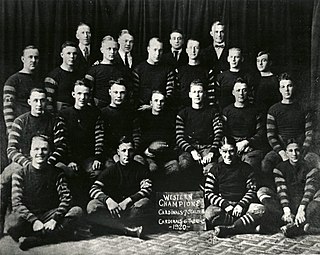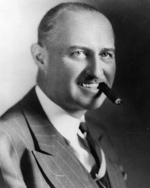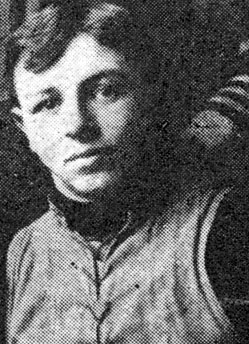History
The Cleveland Indians football team was originally established in 1916 and played in the Ohio League. The team was formed after the Massillon Tigers raided the Akron Indians roster in 1915 and took away many of their star players. That year Peggy Parratt, the Akron Indians player-coach formed the Cleveland Indians with several former ex-Akron Indians players and a few new ex-college players. Despite a winning record, the 1916 Indians season was disappointing, losing twice to the Canton Bulldogs, who were led by Jim Thorpe, and splitting a pair of games with the Columbus Panhandles.
In 1920, when owners of professional teams organized a more structured league, Jimmy O'Donnell, a local sports promoter, obtained the Cleveland franchise. O'Donnell, also the owner of a semi-pro baseball team called the Tigers, was aided in his football venture by Stan Cofall, a football star at Notre Dame from 1914 to 1916, and with the Massillon Tigers. Cofall helped re-organize the Cleveland team in 1919 and, along with O'Donnell attended the September 1920 meeting in Canton, Ohio that founded the American Professional Football Association, which became the NFL the following year. For the first half of the 1920 season, Cofall was the Tigers' player-coach; he was also elected vice-president of the new league.
In their first season, the Cleveland Tigers scored only 2 touchdowns and lost 3 games by 7–0 scores, compiling a record of 1–4–2. For the 1921 season, the name of the team was changed to the Indians, partly because it was a stock name in Cleveland (a baseball team had also used the name since 1915) but more because three Native Americans were signed away from the Canton Bulldogs. In 1921 the Tigers returned with two future Hall of Famers, Joe Guyon and player-coach Jim Thorpe. The team won its first two games. However, during the team's second game, Thorpe injured his ribs and was lost for the season. The Tigers then narrowly lost the next four games. When Thorpe returned to action in a postseason game against the New York Brickley Giants in December, the Tigers were again victorious.
Early in 1922, O'Donnell received league permission to suspend operations for a year, but when he could not post the $1,000 annual guarantee the NFL required, his franchise was canceled. Guyon and Thorpe went off to LaRue, Ohio to form the Oorang Indians. A new Indians franchise was later purchased by Samuel Deutsch who operated the team in 1923. He then relocated the Canton Bulldogs to Cleveland in 1924 and merged them with his Indians team. A third, unrelated Indians team also played in the NFL in 1931.
The Akron Pros were a professional football team that played in Akron, Ohio from 1908 to 1926. The team originated in 1908 as a semi-pro team named the Akron Indians, but later became Akron Pros in 1920 as the team set out to become a charter member of the American Professional Football Association. Fritz Pollard, the first black head coach in the NFL, co-coached the Akron Pros in 1921. Paul Robeson played for the team in 1921 as well. He was among the earliest stars of professional football before football became segregated from 1934 to 1946. In 1926, the name was changed back to the Akron Indians, after the earlier semi-pro team. Due to financial problems, the team suspended operations in 1927 and surrendered its franchise the following year.
Buffalo, New York had a turbulent, early-era National Football League team that operated under multiple names and several different owners between the 1910s and 1920s. The early NFL-era franchise was variously called the Buffalo All-Stars from 1915 to 1917, Buffalo Niagaras in 1918, the Buffalo Prospects in 1919, Buffalo All-Americans from 1920 to 1923, Buffalo Bisons from 1924 to 1925 and in 1927 and 1929, and the Buffalo Rangers in 1926. The franchise, which was experiencing financial problems in 1928, did not participate in league play that season.

The Oorang Indians were a traveling team in the National Football League from LaRue, Ohio. The franchise was a novelty team put together by Walter Lingo to market his Oorang dog kennels. All of the Indians players were Native American, with Jim Thorpe serving as its leading player and coach. The team played in the National Football League in 1922 and 1923. Of the 20 games they played over two seasons, only one was played at "home" in nearby Marion. With a population well under a thousand people, LaRue remains the smallest town ever to have been the home of an NFL franchise, or probably any professional team in any league in the United States.

The Rock Island Independents were a professional American football team, based in Rock Island, Illinois, from 1907 to 1926. The Independents were a founding National Football League franchise. They hosted what has been retrospectively designated the first National Football League game on September 26, 1920 at Douglas Park. The Independents were founded in 1907 by Demetrius Clements as an independent football club. Hence, the team was named the "Independents."
The 1920 APFA season was the inaugural season of the American Professional Football Association, renamed the National Football League in 1922. An agreement to form a league was made by four independent teams from Ohio on August 20, 1920, at Ralph Hay's office in Canton, Ohio, with plans to invite owners of more teams for a second meeting on September 17. The "American Professional Football Conference" (APFC) was made up of Hay's Canton Bulldogs, Akron Pros, the Cleveland Tigers and the Dayton Triangles, who decided on a six-game schedule to play each other at home-and-away, an agreement to respect each other's player contracts, and to take a stand against signing college students whose class had not yet graduated.

The Youngstown Patricians were a semi-professional football team based in Youngstown, Ohio. In the 1910s, the team briefly held the professional football championship and established itself as a fierce rival of more experienced clubs around the country, some of which later formed the core of the National Football League. The Patricians football team motto was "With Malice to None and a Square Deal to all."

The 1920 Akron Pros season was the franchise's inaugural season with the American Professional Football Association (APFA) and twelfth total season as a team. The Pros entered the season coming off a 5–5 record in 1919 as the Akron Indians in the Ohio League. The Indians were sold to Art Ranney and Frank Nied, two businessmen, to help achieve a better record and crowd. Several representatives from the Ohio League wanted to form a new professional league; thus, the APFA was created.
Homer Hurd Davidson was a professional Major League Baseball player for the Cleveland Naps. Born in Cleveland, Ohio, he played only 6 games for the Naps during the 1908 season. Davidson was better known as a professional football player. He played in the Ohio League, which was the direct predecessor to the modern National Football League. One veteran Ohio sportswriter once rated Davidson to be the equal of Walter Eckersall, an infamous quarterback from the University of Chicago. He attended college at the University of Pennsylvania and played on the Penn Quakers baseball team.
The Massillon Tigers were an early professional football team from Massillon, Ohio. Playing in the "Ohio League", the team was a rival to the pre-National Football League version of the Canton Bulldogs. The Tigers won Ohio League championships in 1903, 1904, 1905, and 1906, then merged to become "All-Massillons" to win another title in 1907. The team returned as the Tigers in 1915 but, with the reemergence of the Bulldogs, only won one more Ohio League title. Pro football was popularized in Ohio when the amateur Massillon Tigers hired four Pittsburgh pros to play in the season-ending game against Akron. At the same time, pro football declined in the Pittsburgh area, and the emphasis on the pro game moved west from Pennsylvania to Ohio.

The 1920 Canton Bulldogs season was the franchise's sixteenth and its first in the American Professional Football Association (APFA), which became the National Football League two years later. Jim Thorpe, the APFA's president, was Canton's coach and a back who played on the team. The Bulldogs entered the season coming off a 9–0–1 performance as Ohio League champions in 1919. The team opened the season with a 48–0 victory over the Pitcairn Quakers, and finished with a 7–4–2 record, taking eighth place in the 14-team APFA. A then-record crowd of 17,000 fans watched Canton's week 12 game against Union AA of Phoenixville.

The 1920 Chicago Cardinals season was the Cardinals' inaugural season in the American Professional Football Association. The team finished 6–2–1, earning fourth in the league. Their final two games of the season against the Chicago Stayms Foresters were played after the APFA season was officially over and did not count towards the standings.
The 1920 Cleveland Tigers season was the franchise's inaugural season in the American Professional Football Association (APFA) and fifth total as an American football team. The Tigers entered the season coming off a 5-win, 2-loss, 2-tie (5–2–2) record in 1919. After the 1919 season, several representatives from the Ohio League, a loose organization of professional football teams, wanted to form a new professional league; thus, the APFA was created.
The 1920 Dayton Triangles season was the franchise's inaugural season in the American Professional Football Association (AFPA)—later named the National Football League. The Triangles entered the season coming off a 5–2–1 record in 1919 in the Ohio League. After the 1919 season, several representatives from the Ohio League wanted to form a new professional league; thus, the APFA was created. A majority of the team stayed from the 1919 team, including the coaching staff, while two players left the team.
Ralph George "Fat" Waldsmith was a professional football player during the early years of the National Football League. Waldsmith won an NFL championship with the Canton Bulldogs in 1922. before that season, he played for the Cleveland Indians in the American Professional Football Association, which was the run-up to the NFL.
Jack Cusack was one of the prominent early figures in professional football in Ohio. At the age of twenty-one, Cusack became the manager and owner of the Canton Bulldogs, one of the leading teams of the day. During his six years with the Canton Bulldogs, Cusack led the team to Ohio League championships, in 1916 and 1917, and was responsible for bringing Jim Thorpe into professional football. Cusack also is responsible for helping revive the Bulldogs following the Canton Bulldogs-Massillon Tigers Betting Scandal, which eroded public support for the game from 1906 until 1911. He also ensured that the Bulldogs had a sturdy financial foundation for when they would later enter the National Football League. In 1918, Cusack left football to enter the oil and gasoline business in Oklahoma. He later worked as an independent oil operator in Fort Worth, Texas.

Ralph Edward Hay was the owner of the Canton Bulldogs from 1918 through the 1922 season. However, he is mostly recognized for organizing the first meeting of teams that would later form the American Professional Football Association, later called the National Football League.

George Watson "Peggy" Parratt was a professional football player who played in the "Ohio League" prior to it becoming a part of the National Football League. Born in Cleveland, Ohio, Parratt played quarterback for the Shelby Blues, Lorain Pros, Massillon Tigers, Massillon All-Stars, Franklin Athletic Club of Cleveland, Akron Indians and the Cleveland Tigers between 1905 and 1916. Parratt threw the first legal forward pass in professional football history while playing for the Massillon Tigers on October 25, 1906.
James M. O'Donnell was the owner and co-founder of the first National Football League franchise in Cleveland, called the Cleveland Tigers. He was also the manager of a Cleveland semiprofessional baseball team.
The Union Club of Phoenixville was a professional football team based in Phoenixville, Pennsylvania. The team was the result of a 1919 merger between the Phoenixville Union Club and the upstart Phoenix Athletic Club. From 1907 until 1919, the Union Club was considered one of the best football teams in eastern Pennsylvania. However, in 1919 the upstart Phoenix Athletic Club signed many of the top players of the area, leaving the Union Club no choice but to merge with the Phoenix A.C. The team is best known for defeating the Canton Bulldogs 13–7, in 1920. The team folded in 1921.
The Canton Bulldogs were a professional American football team, based in Canton, Ohio. They played in the Ohio League from 1903 to 1906 and 1911 to 1919, and the American Professional Football Association, from 1920 to 1923, and again from 1925 to 1926. The Bulldogs won the 1916, 1917, and 1919 Ohio League championships. They were the NFL champions in 1922 and 1923. In 1921–1923, the Bulldogs played 25 straight games without a defeat. This remains an NFL record.







